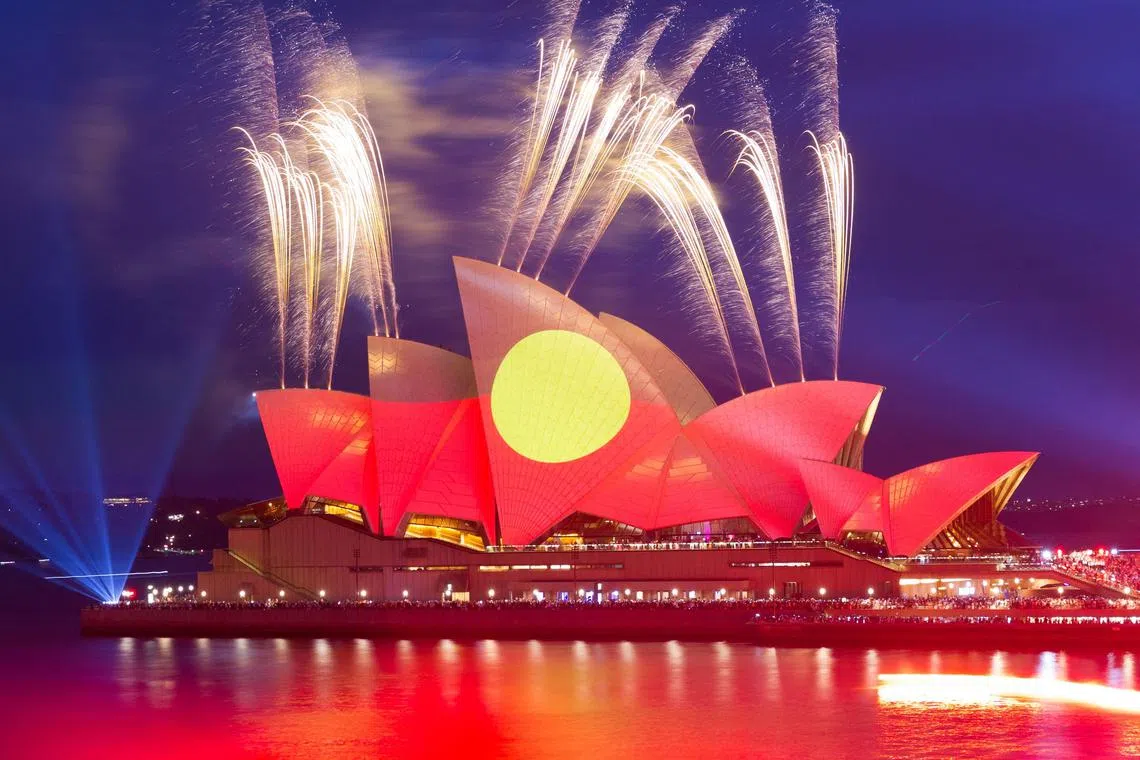Opposition coalition may hold key as Australians gear up for vote to give Aborigines a ‘Voice’
Sign up now: Get ST's newsletters delivered to your inbox

Sydney's Opera House illuminated in the colours of the Aboriginal flag on Australia Day in January.
PHOTO: AFP
Follow topic:
SYDNEY – Later in 2023, Australians will be asked to make a historic choice about the future of their nation.
On that day, probably between October and December, all citizens will vote in a referendum on the formal status of the nation’s Indigenous people,
The referendum will decide whether to formally recognise the Aboriginal and Torres Strait Islands peoples in the federal Constitution and grant them something that has been noticeably absent in the nation’s 122-year history: a permanent voice in the affairs of government.
The Voice would be a body of Indigenous people who could propose input to Parliament and the government on matters that affect them. The aim would be to ensure that Indigenous people have a say on government policies and decisions, though the government would ultimately decide whether to accept any proposals, which would not be binding.
Prime Minister Anthony Albanese is a strong backer of the Voice
Holding back tears in March, Mr Albanese released the wording of the question that will be put at the referendum, saying the proposal would not only improve the lives of Indigenous people but would also be “an inspiring and unifying Australian moment”.
“We share this great island continent with the world’s oldest continuous culture,” he said. “We embrace that as a source of great pride – and we should recognise it.”
He added: “(It is) a sensible and practical proposition that Aboriginal and Torres Strait Islander people should have a say in the decisions and policies that affect their lives.”
Since the arrival of European settlers in the late 1700s, Indigenous people have suffered widespread discrimination and injustice. They were granted voting rights only in the 1960s. Today, they suffer high rates of poverty and imprisonment and, on average, have a life expectancy that is 10 years lower than that of non-Indigenous people and a suicide rate that is twice as high.
The Voice, which was based on proposals by Indigenous people, could shape laws and decisions about issues such as education, welfare, health, policing, heritage protection, and management of remote communities, which are home to about 156,000 of the country’s 984,000 Indigenous people.
Experts say similar institutions have been established in countries such as Sweden and New Zealand, and research shows they have practical benefits.
Two legal experts, Professor Gabrielle Appleby from the University of New South Wales and Mr Eddie Synot from Griffith University, said last week that the Voice was designed by Indigenous people to be the “best solution to respond to their overwhelming feeling of disempowerment and structural disadvantage”.
“Practically, the Voice is informed by decades of research and the experience of people on the ground, that decisions, policies, laws and, most importantly, outcomes are improved when Indigenous peoples are empowered and involved in the process,” they said in an article on The Conversation website.
An opinion survey in March conducted by Resolve Strategic found that 57 per cent support the proposal and 43 per cent are opposed to it. But in some states, such as Queensland and Western Australia, support was only 52 per cent.
The referendum has some prominent critics, including several Indigenous figures who believe the Constitution should not treat Indigenous people differently from the rest of the population and that the Voice will not deliver concrete benefits.
But the big question will be whether the opposition Liberal-National Coalition decides to back or oppose the proposal.
The opposition leader, Mr Peter Dutton, a staunch conservative, has not yet confirmed his view but did not attend Parliament when the referendum Bill was introduced to Parliament last week.
Without bipartisan support, referendums in Australia are almost certain to fail.


